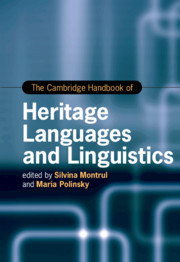Book contents
- The Cambridge Handbook of Heritage Languages and Linguistics
- Cambridge Handbooks In Language And Linguistics
- The Cambridge Handbook of Heritage Languages and Linguistics
- Copyright page
- Dedication
- Contents
- Figures and Tables
- Contributors
- Acknowledgments
- Introduction
- Part I Heritage Languages around the World
- Part II Research Approaches to Heritage Languages
- 15 Heritage Language Research and Theoretical Linguistics
- 16 The Emergence of Heritage Language
- 17 Sociolinguistic Approaches to Heritage Languages
- 18 The Psycholinguistics of Heritage Languages
- 19 Contact Linguistics and Heritage Languages
- 20 A Narrative-Ethnographic Approach to Research on Heritage Language Development
- 21 Corpus-Based Methodologies in the Study of Heritage Languages
- 22 Current Trends and Emerging Methodologies in Charting Heritage Language Grammars
- Part III Grammatical Aspects of Heritage Languages
- Part IV Heritage Language Education
- Index
- References
22 - Current Trends and Emerging Methodologies in Charting Heritage Language Grammars
from Part II - Research Approaches to Heritage Languages
Published online by Cambridge University Press: 04 November 2021
- The Cambridge Handbook of Heritage Languages and Linguistics
- Cambridge Handbooks In Language And Linguistics
- The Cambridge Handbook of Heritage Languages and Linguistics
- Copyright page
- Dedication
- Contents
- Figures and Tables
- Contributors
- Acknowledgments
- Introduction
- Part I Heritage Languages around the World
- Part II Research Approaches to Heritage Languages
- 15 Heritage Language Research and Theoretical Linguistics
- 16 The Emergence of Heritage Language
- 17 Sociolinguistic Approaches to Heritage Languages
- 18 The Psycholinguistics of Heritage Languages
- 19 Contact Linguistics and Heritage Languages
- 20 A Narrative-Ethnographic Approach to Research on Heritage Language Development
- 21 Corpus-Based Methodologies in the Study of Heritage Languages
- 22 Current Trends and Emerging Methodologies in Charting Heritage Language Grammars
- Part III Grammatical Aspects of Heritage Languages
- Part IV Heritage Language Education
- Index
- References
Summary
This chapter contextualizes the methodological landscape of formal linguistic heritage language studies, with an emphasis on emerging, innovative trends using online methods (e.g., eye-tracking, EEG/ERP) and statistical methods modeling the dynamic relationship between outcome measures and extra-linguistic factors. Section 22.1 reviews methodological challenges related to testing heritage speaker (HS) knowledge (e.g., modality of testing, issues pertaining to baselines) as well as the history of offline experimentation that typically compares HSs to monolingual baselines, other more balanced bilinguals, and L2 speakers. Section 22.2 considers recent trends in empirical studies adopting online methods contributing both complementary evidence to the considerably larger offline data dominating the field as well as some challenges for claims made on the basis of offline data alone. Section 22.3 unpacks the emerging trend focusing on the continuum of differences within HSs themselves, attempting to quantify, reveal, and understand correlations of individual experiences (using a variety of regression analyses) with access to and engagement with input as well as opportunities for converting input to intake that might shed light on how and why individual HL grammars develop and end up the way they do.
Keywords
- Type
- Chapter
- Information
- The Cambridge Handbook of Heritage Languages and Linguistics , pp. 545 - 578Publisher: Cambridge University PressPrint publication year: 2021
References
- 10
- Cited by

